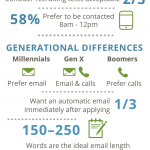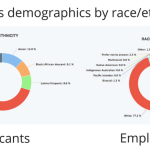3 Hiring Mistakes Most Companies Don’t Realize They’re Making
If your business is like a lot of companies right now, you’re losing critical employees like clockwork at the two-year mark, you’re struggling to nail down your employer brand, and you’ve got too many applicants for some openings and none for others.
To fix these issues, you’re probably throwing different things at the wall to see what sticks, plus using the same recruiting and hiring playbook you’ve referred to for years. Chances are, neither approach is all that effective. Here’s a quick look at a few of the most common errors companies are making in 2016 and how to fix them.
1. Treating All Openings As Equally Important
Some jobs are absolutely critical to your business, while others are important but not crucial. Yet requisitions are often treated like milk in the dairy aisle—first in, first out—regardless of their business impact or the availability of talent. Organizations need a more strategic, business-based approach to allocating hiring resources and methods differently.
Start by identifying which roles are most essential to delivering on future growth commitments—not just to continuing your operations right now. Finding and hiring top talent in those areas is most essential. After all, no one has unlimited resources, and trying to spread them evenly is a recipe for disaster.
Why companies fall into this trap. Companies are often moving too fast to stop and strategize. Especially during high-growth periods, leaders need talent (May 25, 2016) and feel most comfortable with the old-fashioned, full life-cycle hiring approach. But much of the time, that just isn’t realistic.
What to do about it. Take a close look at your business plan, and then start mapping out your talent needs from there. Which factors will really determine your success and help you grow? If you can nail that down, you can start prioritizing the roles that will be most crucial for delivering on those factors. Then start talking about the different recruiting approaches you can take for those openings, depending on what you know about the talent availability for them.
2. Starting A Job Search With A Job Posting
In our experience here at Talent Growth Advisors, we often find that the faster a job is posted, the longer it takes to fill. Why? Because especially for the more critical positions, it takes time to understand the specifications a role will entail, research market availability, and draw up a targeted sourcing plan—much more time than dashing off a quick job listing that ends up missing the mark.
Why companies fall into this trap. Planning (or “intake”) meetings are often shortchanged when hiring managers and recruiters lack the capacity, capability, or willingness to get the job done right up front. Urgency gets communicated at the expense of virtually everything else.
What to do about it. Conducting a detailed planning meeting up front is essential to understanding the role: Why it’s open, what necessary knowledge candidates should have, and the appropriate talent sources to pursue. This will take longer, yes, but it’ll probably lead to better accuracy—and speed—in recruiting once you finally do put up a job listing.
3. Being Unclear About Who’s Accountable For Recruiting Success
When asked, most managers don’t have a concrete sense of what “good performance” in hiring looks like. This is a huge problem because, without that definition in place, hiring managers and recruiters simply have to make assumptions. They might determine that “good” is filling the job quickly or saving money on a search. Ultimately, talent leaders need to determine how to measure success for everyone involved in the hiring process.
Why companies fall into this trap. Historically, hiring has been seen as either an administrative or sales-focused role, the former being exceedingly tactical, the latter dealing with people in unpredictable ways. It wasn’t often clear how to create effective measures of success, so they often went undefined.
What to do about it. Bring the same rigor you apply to business strategy to your recruiting process—after all, those two things are intimately linked. Clarifying goals, roles, responsibilities and measures of success across levels and functions, through detailed process design, is the best way to gain clarity and accountability.
Talent can make or break team performance in fast-growth companies, yet it’s often neglected. And especially in the current business landscape, that can have enormous competitive costs. So start by looking out for these common pitfalls, and you’ll be able to begin saving time and money, all while keeping your company’s growth on track.
Linda Brenner is coauthor of Talent Valuation and the founder and CEO of Talent Growth Advisors, a talent advisory group focused on connecting human capital to market capital for brands of all sizes.
Fast Company , Read Full Story
(16)














